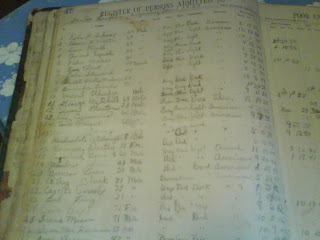***Special Thanks to Darrell Todd Maurina of Pulaski County Daily for allowing us to reprint his article.
Commissioners OK effort to research history of Pulaski County Poor Farm
By: Darrell Todd Maurina
PULASKI COUNTY, Mo. (Dec. 31, 2009) — In one of their last actions for 2009, Pulaski County Commissioners voted Thursday to approve a request by Laura Huffman and Marge Scott to do research in the county archives for the history of what was once the Pulaski County Poor Farm.
Located on Superior Road, the low-level bottomland road between Waynesville and Saint Robert that parallels the higher-level ridge road that later became Route 66, the Pulaski County Poor Farm was a place where indigent residents went to earn a living if they couldn’t do so on their own. Developed prior to Depression-era concepts of welfare and public assistance, most counties once had poor farms so people would have a place to live while working to support themselves.
Located near what’s now the Laughlin family farm, the Pulaski County Poor Farm also had a cemetery for its residents; Huffman and Scott said many of the cemetery graves are in disrepair and others aren’t marked with headstones or their locations aren’t known at all.
Commissioners OK effort to research history of Pulaski County Poor Farm
By: Darrell Todd Maurina
PULASKI COUNTY, Mo. (Dec. 31, 2009) — In one of their last actions for 2009, Pulaski County Commissioners voted Thursday to approve a request by Laura Huffman and Marge Scott to do research in the county archives for the history of what was once the Pulaski County Poor Farm.
Located on Superior Road, the low-level bottomland road between Waynesville and Saint Robert that parallels the higher-level ridge road that later became Route 66, the Pulaski County Poor Farm was a place where indigent residents went to earn a living if they couldn’t do so on their own. Developed prior to Depression-era concepts of welfare and public assistance, most counties once had poor farms so people would have a place to live while working to support themselves.
Located near what’s now the Laughlin family farm, the Pulaski County Poor Farm also had a cemetery for its residents; Huffman and Scott said many of the cemetery graves are in disrepair and others aren’t marked with headstones or their locations aren’t known at all.
 Laura Huffman & Marge Scott at the Dec 31, 2009 Pulaski County Commissioner's Meeting. Photo courtesy of Darrell Todd Maurina of Pulaski County Daily
Laura Huffman & Marge Scott at the Dec 31, 2009 Pulaski County Commissioner's Meeting. Photo courtesy of Darrell Todd Maurina of Pulaski County DailyCounty Clerk Diana Linnenbringer told commissioners at Monday’s meeting that she had received a request to look through the old county records and minutes beginning in 1903 for the poor farm; commissioners were receptive to the request but wanted more details.
Commissioner Bill Farnham questioned how much would be in the official county records.
“They probably ought to go find one of the elderly citizens of this county, such as my aunt Maxine, who knows the history of this county. They’d probably find more detailed information from her than they’d find in the official records of the county,” Farnham said.
“It is a matter of public record, isn’t it?” asked Commissioner Ricky Zweerink.
That’s not necessarily the case under the Missouri State Sunshine Law, which allows government agencies to withhold records involving “welfare cases of identifiable individuals.” That’s not a commonly known exception on the local government level, but it’s currently being used by the Pulaski County Sewer District and by the utility boards of some local cities when residents appeal their utility bills.
When commissioners met again on Thursday, they discussed the matter directly with Huffman and Scott, noting that while most and possibly all of the Pulaski County Poor Farm residents are no longer alive, some of their children or grandchildren still live in the area.
“If you see anything that would embarrass any of the descendants, please be sensitive,” asked Presiding Commission Don McCulloch.
“Oh, we will,” Huffman assured the commissioners.
“This is mostly so we can document those cemetery plots and know where they are,” Scott said. “We just need to see the books and if after those two days she feels she needs more time, we’ll get back with you and schedule a day.”
“We wish you well and if there is anything we can do to help, let us know,” McCulloch said.






